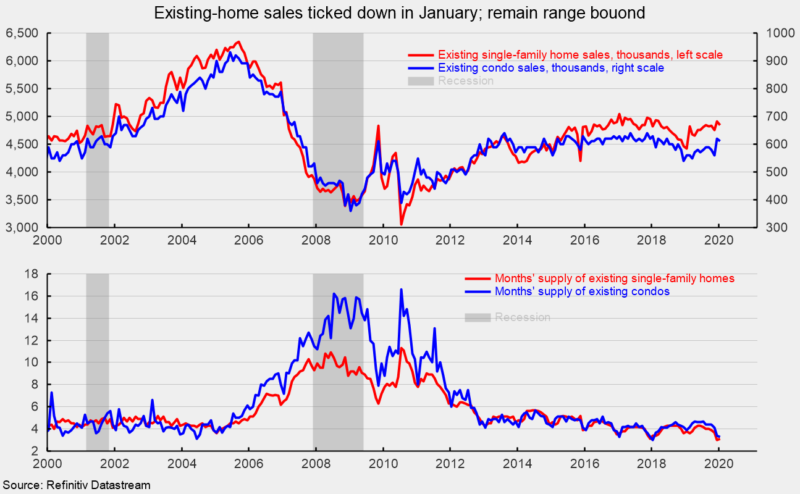Existing-Home Sales Remain Range Bound; Inventory Remains Tight
Sales of existing homes fell 1.3 percent in January to a 5.46 million seasonally adjusted annual rate. Sales are still up 9.6 percent from a year ago and have fully recovered from a slowdown during 2018. However, sales are about even with levels from 2015 through 2017.
Sales were down in one region, flat in one, and up in two regions in January: sales were off 9.4 percent in the West but are still up 8.2 percent from the year-ago level; sales were unchanged in the Northeast, leaving sales 7.4 percent above year-ago levels; sales rose 0.4 percent in the South, the largest region by volume, leaving that region’s sales rate 11.7 percent above the year-ago pace; and sales gained 2.4 percent for the month in the Midwest and are 8.4 percent above the January 2019 rate.
Sales in the market for existing single-family homes, which account for just under 90 percent of total existing-home sales, fell 1.2 percent in January, coming in at a 4.85 million seasonally adjusted annual rate (see top chart). From a year ago, sales are up 9.7 percent. The January pace is about in line with the mid-2016 pace. Sales of existing single-family homes have been in a range of 4.4 million to 5 million since mid-2015, well below the peak pace of 6.34 million from September 2005 (see top chart).
By region, sales for existing single-family homes followed the same pattern as total existing homes: sales were off 9.7 percent in the West but are still up 8.1 percent from the year-ago level; sales were unchanged in the Northeast, leaving sales 7.0 percent above year-ago levels; sales rose 1.0 percent in the South, leaving that region’s sales rate 12.3 percent above the year-ago pace; and sales gained 1.7 percent for the month in the Midwest and are 8.0 percent above the January 2019 rate.
Condo and co-op sales posted a 1.6 percent drop for the month, putting sales 8.9 percent ahead of the January 2019 pace. Sales came in at a 610,000 pace for the month, matching the September 2013 pace. Since early 2013, sales of existing condos and co-ops have remained in a range of 540,000 to 640,000, well below the peak of 930,000 from June 2005 (see top chart).
Total inventory of existing homes for sale rose 2.2 percent to 1.42 million in January, pushing the months’ supply (inventory times 12 divided by the annual selling rate) to 3.1, from 3.0 in December. For the single-family segment, the months’ supply also rose to 3.1 from 3.0 while the condo and co-op months’ supply fell to 3.3 from 3.4. Both are close to record lows (see bottom chart).
With mortgage rates holding at very low levels and unemployment at multidecade lows, there may not be a significant catalyst to sharply boost sales, suggesting sales are unlikely to move significantly higher in the coming months. Furthermore, new-home construction has been increasing recently but the sales have been somewhat softer, pushing the months’ supply higher.
Still, consumers generally are in good financial shape, supported by a tight labor market, rising incomes, strong balance sheets, and generally high levels of consumer confidence. The main risks on the horizon continue to be uncertainty surrounding trade policy and fallout from ongoing trade wars, deep partisanship that could impact consumer and/or business confidence, and the recent outbreak of the coronavirus. While the most likely course remains continued economic expansion, caution is warranted.






